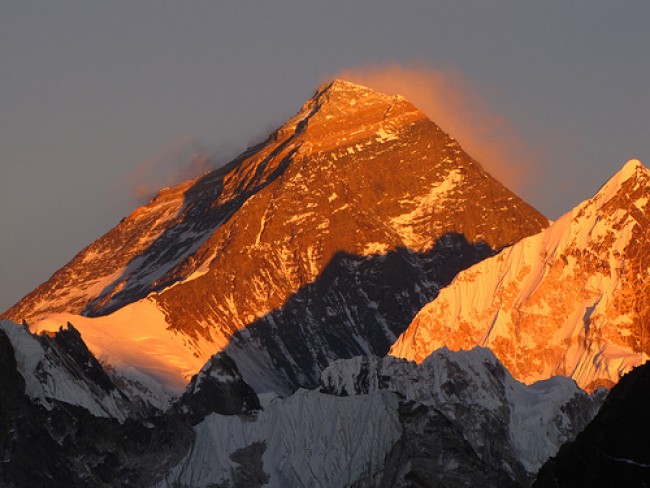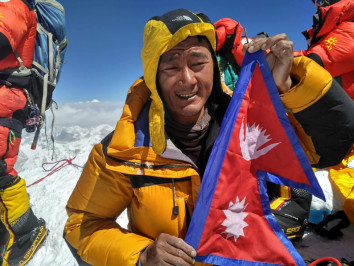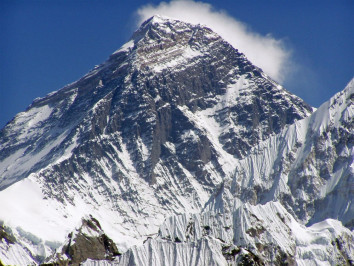Nepal’s New Everest Climbing Rules and Regulations for 2026/27

 Kedar Neupane
7th Aug, 2025
Kedar Neupane
7th Aug, 2025
Kedar Neupane
I am Kedar Neupane, a passionate traveler, entrepreneur, mentor, and social contributor, born and raised in a village near the Nepal-China border in Sindhupalchok, Nepal. With a Master’s degree in Business from Tribhuvan University and Level 2 proficiency in the German language, I have dedicated my life to tourism, trade, mentorship, and holistic well-being.
🌍 A Global Explorer with a Vision
Having explored 26+ countries, I have gained profound insights into diverse cultures, business landscapes, and global tourism. My travels have taken me to:
🇹🇭 Thailand | 🇧🇹 Bhutan | 🇲🇾 Malaysia | 🇸🇬 Singapore | 🇨🇳 China | 🇭🇰 Hong Kong | 🇩🇪 Germany | 🇵🇱 Poland | 🇦🇹 Austria | 🇨🇭 Switzerland | 🇭🇺 Hungary | 🇳🇱 Netherlands | 🇧🇪 Belgium | 🇫🇷 France | 🇦🇪 UAE | 🇬🇧 UK | 🇺🇸 USA | 🇹🇷 Turkey | 🇶🇦 Qatar | 🇮🇳 India | 🇮🇩 Indonesia | 🇨🇦 Canada
Through my journeys, I have developed a deep appreciation for cultural exchange, adventure tourism, and sustainable business practices.
🏔️ Entrepreneurial & Professional Journey
I am actively involved in tourism, trade, and mentorship, leading multiple ventures that promote sustainable travel, adventure tourism, and business development:
✔ Founder & MD – Actual Adventure Pvt. Ltd. (A leading adventure travel company in Nepal)
✔ CEO – Himalayas Destination Management Company (Creating premium travel experiences)
✔ MD – Nepal Export & Import Pvt. Ltd. (Promoting Nepalese products globally)
✔ MD – Actual Mentor Pvt. Ltd. (Empowering entrepreneurs and professionals)
✔ Chairman – World Expedition Nepal (Focusing on high-altitude expeditions and trekking)
Through my entrepreneurial journey, social contributions, global explorations, and commitment to lifelong learning, I strive to inspire others to pursue their passions while making a meaningful difference. My dream is to build a world where travel, business, and holistic well-being come together, fostering growth, sustainability, and happiness for all.
Nepal has officially announced a comprehensive update to the Everest climbing rules and regulations for 2025/26. These changes, effective from September 1, 2025, are intended to address overcrowding, safety concerns, environmental degradation, and improve the overall expedition experience. The new rules affect eligibility, permits, guides, health insurance, and more.
Table of Contents
Everest Climbing Rules – Old vs. New (Proposed)
| Category | Old Rules | New Proposed Rules (Integrated Tourism Bill) |
|---|---|---|
| Experience Requirement | No mandatory high-altitude climbing experience required (after 1996 reversal). | Climbers must have summited a 7,000m+ peak before attempting Everest. |
| Health Checkup | No strict health certification required. | Medical certificate issued within 1 month by a government-approved health institution required. |
| Insurance Coverage | Covered accidents, search & rescue, and medical emergencies only. | Insurance to also include dead body retrieval from the death zone. |
| Garbage Management | Climbers and agencies responsible for waste deposit and cleanup, often poorly enforced. | Department of Tourism to take direct responsibility for garbage collection and management. |
| Search & Rescue | Often conducted by a mix of agencies, individuals, and informal groups. | Only licensed travel companies allowed to conduct search & rescue, with penalties for violations. |
| Sherpa Job Protection | No specific protection measures. | Legal provisions to protect Sherpa employment rights and working conditions. |
| Liaison Officers | Climbers often personally fund liaison officers, leading to alleged corruption. | No change – issue remains unaddressed in the bill. |
| Crowd Management | No cap on climber numbers; first-come, first-served permits. | Experience requirement expected to reduce inexperienced climbers and overcrowding. |
Who Can Climb Everest in 2025/26?
- Climbers must have previously summited a 7,000-meter or higher peak in Nepal.
- Climbs outside Nepal or peaks under 7,000m do not fulfill this requirement.
- Designed to ensure climbers possess high-altitude experience within Nepal.
New Everest Permit Fees and Validity
- Spring (March–May): USD 15,000 (up from USD 11,000)
- Autumn: USD 7,500 | Winter: USD 3,750
- Nepali Citizens: Approx. NPR 150,000 during spring
- Permit Validity: Reduced to 55 days (previously 75 days)
Guide Regulations and Solo Climb Ban
- Solo climbing is banned on all 8,000m peaks including Everest.
- Guide Ratio: Minimum 1 certified Nepali guide per 2 climbers.
- All guides and expedition leaders must be citizens of Nepal.
Health and Insurance Requirements
- Medical Certificate: Mandatory, issued within 30 days from a Nepal government-recognized hospital.
- Insurance: Death and body repatriation insurance of at least NPR 5 million (~USD 37,500).
- Insurance must be acquired in Nepal through authorized providers.
Environmental and Safety Rules
- Climbers must use biodegradable human waste bags and follow pack-in-pack-out rules.
- Mandatory GPS tracking devices must be carried by all climbers.
- Expeditions monitored by government-appointed rangers and security forces.
- Introduction of a mountain cleanup fund expected in upcoming seasons.
Summary Table: Everest Climbing Rules 2026/27
| Category | New Rule |
|---|---|
| Permit Fee (Spring) | USD 15,000 (foreign climbers) |
| Permit Validity | 55 days |
| Experience | Must climb a 7,000m+ peak in Nepal |
| Solo Climbing | Prohibited on all 8000m peaks |
| Guide Requirement | 1 guide per 2 climbers (Nepali only) |
| Medical Certificate | Required within 30 days |
| Insurance | Minimum NPR 5 million coverage |
| Tracking Device | Mandatory GPS device |
| Waste Management | Biodegradable bags mandatory |
Purpose of These New Regulations
- To reduce overcrowding and improve traffic flow on summit day.
- To enhance climber safety through pre-screened experience and health.
- To increase employment opportunities for Nepali guides and operators.
- To protect the fragile Himalayan environment through strict waste policies.
Climbing Everest Legally in 2025/26: Nepal’s New Rules & Regulations Explained
Climbing Mount Everest has always symbolized the pinnacle of human endurance, ambition, and adventure. But due to overcrowding, accidents, and a rise in unprepared climbers, Nepal has introduced new Everest climbing rules for 2025/26 to make the world's highest peak safer and more sustainable.
Beyond 2026: Looking to Everest’s Future
Nepal’s new climbing regulations represent a decisive shift in how expeditions are permitted and managed. These measures aim to protect climbers’ lives, reduce environmental degradation, and uphold the legacy of Everest. While these changes may seem strict, they are ultimately designed to professionalize the mountaineering experience and promote safe, responsible ascents.
FAQ: Understanding the New Everest Climbing Regulations
1. What are the new rules for climbing Mount Everest in 2025/26?
The new Everest climbing regulations in Nepal for 2025/26 include several key updates:
-
Experience Requirement: All climbers must have successfully summited a 7,000-meter peak in Nepal before applying for an Everest permit.
-
Ban on Solo Expeditions: Solo climbing is no longer allowed. Every climber must be accompanied by a certified Nepalese mountain guide.
-
Mandatory Nepalese Guide: Climbers must be part of an expedition organized by a licensed agency, with a guide certified by the Nepal Mountaineering Association (NMA).
-
Medical Fitness Requirement: A medical clearance certificate must be provided, proving the climber is physically fit for high-altitude climbing.
-
Insurance Requirements: Climbers must have valid Nepal mountaineering insurance, covering emergency evacuation, rescue, and medical expenses.
-
Environmental Protocols: Expedition operators must follow stricter rules regarding waste management, including a refundable garbage deposit and mandatory waste collection.
-
Increased Permit Fees: The Everest permit cost remains $11,000 USD for foreign climbers, but additional fees apply for liaison officers, logistics, and garbage management.
These rules are designed to ensure only well-prepared and responsible climbers attempt to scale Everest.
2. Why do climbers on Everest follow the 2 p.m. rule?
The 2 p.m. rule on Mount Everest is a life-saving safety guideline. It states that if climbers haven't reached the summit by 2:00 p.m., they should turn back.
Reasons include:
-
Daylight Hours: Descending in darkness is highly dangerous, especially in extreme cold and difficult terrain.
-
Energy Depletion: After hours of climbing in thin air, climbers can suffer from exhaustion and disorientation.
-
Weather Changes: Afternoon storms are common and deadly at high altitudes.
-
Death Zone Dangers: The “Death Zone” (above 8,000 meters) has oxygen levels too low to sustain human life for long. Time management is critical to avoid fatal mistakes.
Following the 2 p.m. rule has saved countless lives and is now a standard part of all professionally guided expeditions.
3. Do I need prior experience to climb Everest under the new regulations?
Yes. Experience is now a mandatory requirement.
Under the Everest climbing rules 2025/26, climbers must have:
-
Successfully climbed a 7,000-meter peak in Nepal, such as Himlung, Baruntse, or Putha Hiunchuli.
-
Proof of this ascent is required during the permit application process.
-
Experience must be verifiable and certified by the Nepalese authorities or a recognized expedition agency.
This ensures that climbers understand high-altitude physiology, are capable of self-rescue, and can endure the mental and physical challenges of Everest.
4. Why is a Nepalese guide now mandatory for Everest expeditions?
The Everest guide rules now mandate that:
-
All climbers must hire a certified Nepalese mountain guide.
-
The guide must be assigned through a registered expedition operator in Nepal.
Why this change?
-
Safety First: Guides are trained in rescue techniques, weather assessment, and route management.
-
Local Expertise: Nepalese guides, especially Sherpas, have intimate knowledge of Everest’s terrain and weather patterns.
-
Supporting the Local Economy: This rule ensures that tourism revenue benefits Nepalese workers and communities.
-
Team Communication: Guides help with translation, coordination, and communication with base camp staff and rescue teams.
Climbing Everest legally now means respecting this regulation, ensuring you are accompanied by someone who prioritizes your safety and success.
5. How does the “Death Zone” affect climbers on Everest?
The Death Zone refers to the region above 8,000 meters (26,247 ft) where oxygen levels are so low that the human body starts to deteriorate.
Effects of the Death Zone:
-
Oxygen Deprivation: Blood oxygen saturation drops dangerously low, impairing judgment and coordination.
-
Altitude Sickness: Risk of HAPE (High-Altitude Pulmonary Edema) and HACE (High-Altitude Cerebral Edema) increases sharply.
-
Muscle Breakdown and Mental Confusion: Climbers often feel dizzy, weak, and disoriented.
-
Cold Exposure: With less circulation and extreme wind chills, frostbite can occur within minutes.
-
Supplemental Oxygen Required: Almost all climbers use bottled oxygen in the Death Zone to survive.
Because of this, time spent in the Death Zone is minimized, and climbers aim for fast summit pushes and immediate descents.
Everest Permit Cost 2025/26
| Category | Cost (USD) |
|---|---|
| Foreign Nationals | $11,000 per person |
| Indian Nationals | $750 (via Indian Alpine Club) or $4,000 directly |
| Nepalese Nationals | NPR 75,000 |
| Garbage Deposit | $4,000 (refundable if waste is returned) |
| Liaison Officer Fee | ~$3,000 – $5,000 (depends on group size) |
Additional logistics (food, oxygen, Sherpa wages, insurance) cost around $30,000 – $70,000+ depending on the expedition type.
Nepal Mountaineering Insurance Requirements
All climbers must have the following:
-
Rescue and Evacuation Insurance (up to $100,000 coverage)
-
Travel Insurance (covers flight delays, cancellations)
-
Medical Insurance (covers illness, frostbite, altitude sickness)
-
Climbing Insurance (some insurers offer specialized packages for high-altitude mountaineering)
Nepalese guides and porters must also be insured under the Labor Act or NMA guidelines.
New Rules for Climbing Mt. Everest – Balancing Adventure, Safety, and Sustainability
Standing at 8,848.86 metres, Mt. Everest continues to be the ultimate dream for mountaineers worldwide. Since Tenzing Norgay Sherpa and Sir Edmund Hillary’s legendary first ascent in 1953, nearly 9,000 climbers have reached the summit from the Nepal side.
Every spring season, hundreds of climbers from around the globe flock to the Khumbu region to attempt the world’s highest peak. In 2024 alone, more than 400 climbers secured permits for the spring season, with numbers expected to rise to at least 500 climbers—and over 1,000 people if we include guides and support staff.
While this boom in mountaineering significantly boosts Nepal’s economy, it also brings serious challenges:
-
Traffic jams in the “death zone”
-
Rising fatalities (17 deaths in 2023, 8 in 2024)
-
Melting glaciers caused by climate change
-
Growing piles of trash, earning Everest the unfortunate nickname “world’s highest garbage dump”
The Push for Stronger Everest Regulations
In response to these growing concerns, the Supreme Court of Nepal issued an order in 2023 directing authorities to regulate Everest expeditions more effectively. Following this, the Department of Tourism introduced the Integrated Tourism Bill in Parliament with several new provisions aimed at making climbing safer and more sustainable.
Key Proposed Changes in the Everest Climbing Rules
-
Mandatory High-Altitude Experience
-
Climbers must have successfully summited a peak over 7,000 metres before attempting Everest.
-
This aims to filter out inexperienced climbers who risk their own lives and those of Sherpa guides.
-
-
Health Certification
-
All climbers will need a medical fitness certificate issued within one month of the climb from a government-approved health institution.
-
Those deemed unfit will not be allowed to climb.
-
-
Improved Insurance & Body Retrieval Provisions
-
Insurance policies will now cover dead body retrieval from the death zone, in addition to accidents, health, and rescue operations.
-
-
Better Garbage Management
-
The Department of Tourism will be directly responsible for waste management and cleanup operations in the Everest region.
-
-
Regulated Search & Rescue Operations
-
Only licensed travel companies will be allowed to conduct search and rescue missions, with strict penalties for violations.
-
-
Protection of Sherpa Jobs
-
The bill ensures that Sherpa employment rights are protected, recognizing their vital role in Himalayan mountaineering.
-
History Repeats Itself?
Interestingly, this is not the first time Nepal has tried to enforce experience requirements. In 1995-96, climbers needed to have summited a 6,000-metre peak before attempting Everest. However, due to pressure from mountaineers and a decline in expedition numbers, the rule was reversed.
This time, the challenge will be maintaining the balance between safety, sustainability, and tourism revenue.
Lingering Concerns
While the proposed bill is a big step forward, it does not address certain long-standing issues, such as:
-
Climbers having to personally pay for liaison officers—a practice critics say encourages corruption.
-
The reality that accidents can happen at any altitude, not just above 7,000 metres.
Why These Changes Matter
Climbing Mt. Everest is not just about reaching the top—it’s about preparation, patience, and respect for the mountain. Harsh conditions, the need for careful acclimatization, and the risks of high-altitude sickness make it one of the most dangerous adventures on Earth.
By introducing stricter rules, Nepal hopes to:
-
Reduce overcrowding and accidents
-
Protect the fragile Himalayan environment
-
Improve the image of Everest as a world-class mountaineering destination rather than a commercialized, polluted peak
A Step Towards Saving Everest
Everest is more than a climbing challenge—it is a cultural and ecological treasure. The rapid melting of the Khumbu Glacier threatens both the region’s environment and the lives of communities downstream. For decades, Everest has been treated as a cash cow, often with little regard for preservation or human safety.
Now, the focus must shift to finding a sustainable balance between adventure tourism and conservation. Everest can continue to inspire the world, but only if it is respected and protected for generations to come.
Key Takeaway:
The new Everest climbing rules aim to make mountaineering safer, protect Sherpas, and safeguard the environment. For climbers, this means more preparation and responsibility—but also a better chance at a safe and meaningful summit.
Conclusion: A Safer, Smarter Everest Climb Beyond 2026
The updated Everest climbing regulations in Nepal for 2025/26 aim to make mountaineering more professional, less commercialized, and significantly safer. While these rules add more layers of preparation, they protect the mountain, support the local economy, and safeguard climbers.
Climbers must now approach Everest with genuine skill, experience, and respect. Climbing Everest legally from Nepalis no longer a luxury tourism product but a serious athletic and logistical endeavor—exactly as it should be.
Planning Your Everest Expedition in 2026/27
These rules will apply to all expeditions from September 1, 2025, onward. Ensure you meet the experience, medical, and insurance requirements. Partnering with a registered company like Actual Adventure Pvt. Ltd. guarantees compliance, safety, and seamless logistics.
Need Help Organizing Your Everest Climb?
Contact Actual Adventure Pvt. Ltd.
📧 Email: info@actual-adventure.com
🌐 Website: www.actual-adventure.com
Read more : Everest climbing rules 2025/26, new Everest regulations Nepal, Everest permit cost, Nepal mountaineering insurance, Everest guide rules, climbing Everest legally, climb Everest from Nepal
Recent Posts

19th Nov, 2025

19th Nov, 2025

27th Oct, 2025

28th Aug, 2025





.jpeg)










